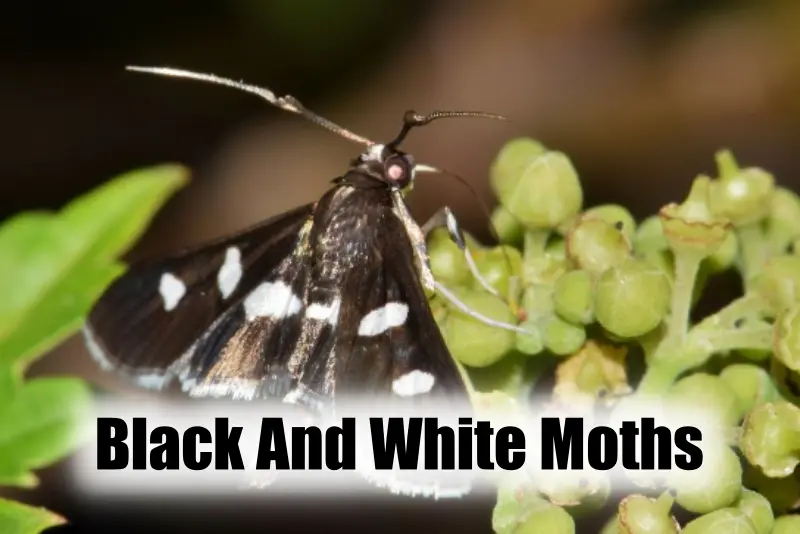There’s no need for a debate when it comes to the most classic color combination—black and white. It is well established that black and white is the evergreen combination of colors that could pair up with literally anything. For insect enthusiasts, exploring the world of these 15 black and white moth species can add a modern yet elegant touch to your garden.
So, without further ado, let’s dive into the fascinating realm of black and white moths.
15 Black And White Moth Species
1) Giant Leopard Moth
Scientific Name: Hypercompe scribonia
Size: Approximately 30–76 mm
The wings of the giant leopard moth are bright white with a distinctive pattern of neat black blotches, some solid and some hollow.
The overside of the abdomen is dark blue with orange markings, while the underside is white with solid black spots.
Adult giant leopard moths are strictly nocturnal, flying primarily at nightfall. They do not generally fly before nightfall.
2) White Satin Moth
Scientific Name: Leucoma salicis
Size: 37 to 50 mm
The white satin moth exhibits predominantly white wings, sometimes with ochreous tones with males, having a blackish costal margin.
The head, collar, and pectinations of the antennae are dark. Tibiae and tarsi feature broad black rings.
It is found in Europe, including the British Isles, but not in the far north. Its distribution extends eastward across the Palearctic region to Japan. It was also introduced to North America in the 1920s.
Females lay eggs in clusters on tree trunks, covered with a paper-like substance.
Larvae are black with light dorsal spots and a yellow lateral line.
3) White Ermine
Scientific Name: Spilosoma lubricipeda
Size: Ranges from 34 to 48 mm
The wing pattern of the white ermine is highly variable, ranging from entirely white wings to individuals with wings covered with black dots.
The antennae branches are notably long, being 3–5 times longer than the diameter of the antenna stem. The abdomen is orange with black dorsal dots.
The eggs are light yellow, and the larvae, are lilac-brown with deep dark brown hair and an orange-yellow dorsal stripe.
The larvae feed on various plants including stinging nettle, Cytisus scoparius, alfalfa, Echium vulgare, and Taraxacum officinale.
4) Eight-spotted Forester
Scientific Name: Alypia octomaculata
Size: 30–37 millimetres
The Eight Spotted Forester is predominantly black with distinctive white, cream, or yellow shades on its forewings.
It is named the “eight-spotted forester” due to the presence of two spots on each wing, totaling eight spots.
It is diurnal, that is they are active during the day.
Larvae feed on the underside of leaves and stems of grapevines, peppervines, and Virginia creepers, making them somewhat of a pest in commercial and decorative vineyards.
As a defense mechanism, when threatened, the larvae vomit a foul orange-tinted liquid.
5) Salt Marsh Moth
Scientific Name: Estigmene acrea
Size: 4.5 to 6.8 centimeters
The forewing of the salt march moth is white with a variable pattern of black spots, with some individuals lacking any spots.
The hindwing is yellow-orange in males and white in females, with both sexes displaying three or four black spots or blotches on the hindwings.
The larva, known as the salt marsh caterpillar, is found in a variety of colors, ranging from pale yellow to rusty orange-brown to dark brownish-black.
It is not affected by pyrrolizidine alkaloids present in many plant families and can detoxify these alkaloids and convert them into sex pheromones, showcasing unique adaptations.
6) Buck moth
Scientific Name: Hemileuca maia
Size: wingspan is about 50-75 mm
The buck moth showcases a captivating black-and-white pattern, a common trait among Saturniidae moths.
The larvae of the buck moth have hollow spines connected to a poisonous gland capable of inducing stinging, itching, burning, and even nausea in humans.
It primarily feeds on various oak species, including scrub oak, live oak, blackjack oak, white oak, and dwarf chinquapin oak.
7) Fall webworm
Scientific Name: Hyphantria cunea
Size: 35–42 mm
The adult fall webworm is usally white-colored, with some of them having dark-colored black or brown marks.
The larval stage, on the other hand, displays a wide range of colors, from pale yellow to dark grey, adorned with yellow spots and bristles.
Fall webworms are social insects, constructing communal webs on tree branches for mating, temperature regulation, and protection.
Their larvae also employ defensive behaviors, including synchronized shaking, emitting repellant scents, and possessing irritants on their hairs.
8) Clymene Moth
Scientific Name: Haploa clymene
Size: 40 to 55 mm
The forewings of the Clymene moth exhibit a creamy yellow hue with a partial brown-black border, while the hindwings feature yellow-orange tones with one or two brown-black spots.
Belonging to the tiger moth subfamily Arctiinae, tribe Arctiini, the Clymene moth’s spiny brownish-black larva is adorned with a yellow middorsal stripe typical of the tiger moth species.
The Clymene moth typically follows a univoltine life cycle, meaning it experiences one brooding season per year.
9) Ermine Moths
Family: Yponomeutidae
Size: 8 to 31 mm
Ermine moths, belonging to the family Yponomeutidae, vary in size from 8 to 31 mm.
These moths have heads covered with smooth scales, with their wings often exhibiting white, pale grey, or drab coloration with dark speckles.
Primarily nocturnal, adult ermine moths have long wings with fringes on the trailing edges of the hindwings.
Ermine moth larvae engage in various feeding habits, including leaf-webbing, leaf skeletonizing, leaf mining, or needle mining.
10) Redbud Leaffolder
Scientific Name: Fascista Cercerisella
Size: Ranges from 13 to 16 mm
The redbud leaf folder is a black or very dark brown moth with contrasting white spots on its wings.
Active from April to October in the southern part of its range, it may have one or two generations per year.
When disturbed, the caterpillars display vigorous activities, including thrashing and dropping into the soil.
11) Rustic Sphinx
Scientific Name: Manduca rustica
Size: 8.7 – 15 cm
The adult male Rustic Sphinx displays a unique coloration with intricate and beautiful patterns on its wings, especially notable from a ventral view.
This species, found in the southern United States, exhibits adaptability across diverse habitats, from rainforests to deserts.
The Rustic Sphinx is often seen feeding on plants from families like Verbenaceae, Convolvulaceae, Lamiaceae, and Boraginaceae.
12) Harris’s three-spot
Scientific Name: Harrisimemna trisignata
Size: 30 to 36 mm
The Harris’s Three Spot gets its name from the unique markings on its wings.
The intricate amalgamation of black and white on its wings adds oomph to nature’s artistry.
This is a North American species, found in the regions of Ontario, Quebec, New Brunswick, Nova Scotia, Newfoundland, and Labrador in Canada, all the way down to the warm state of Arizona in the United States.
The moth’s larvae have a diverse menu that includes various woody plants. From the delicious wild raisin and winterberry to the savory bush honeysuckle, black willow, white ash, and even the classic apple.
13) White Spotted Sable
Scientific Name: Anania funebris
Size: 20 to 23 mm
A diurnal day flyer with a wingspan measuring approximately 20–23 mm and jet-black forewings adorned with a large round white spot before the middle and a second one beyond the middle.
These moths have a sneaky habit of swiftly hiding behind leaves when they sense danger, as well as as a precautionary measure.
They are seen high up in the sky from May to June, with peak activity noted in June and July.
Their larvae have a very picky palette, exclusively feeding on the leaves of Goldenrod (Solidago) and sometimes on Dyer’s Greenweed
14) Spotted Peppergrass Moth
Scientific Name: Eustixia pupula
Size: Approximately 17 mm
The spotted peppergrass moth belongs to a one-species-only genus, making it quite an important species.
It was first described and named by the renowned Jacob Hübner in 1823.
The spotted peppergrass moth has white forewings that are beautifully adorned with large, spaced-out black spots.
They often take to the skies from June to August (and sometimes even March in Texas) and is highly attracted to light.
It feeds on plants from Lepidium species and sometimes even a bit of cabbage.
15) Zebra Conchylodes Moth
Scientific Name: Conchylodes ovulalis
Size: 23 to 30 mm
Adult moths of the zebra conchylodes moth exhibit distinctive coloration. It has white wings displaying a dark violet sheen.
The forewings have six blackish-brown lines, giving it a zebra-like appearance.
The zebra conchylodes moth is found in various regions, ranging from the United States to further south through Mexico and Costa Rica, extending to Colombia.
Their larvae have been seen feeding on species within the Asteraceae family.
Conclusion
The yin and yang(s) of the moth kingdom are here to captivate your mind. These 15 wonderful species of black and white moths have hopefully piqued your interest.
If you are like me, one is never enough. Browse through our website to quench your thirst for knowledge!
Also Read:

Hi everyone, my name is Shawna, and I’ve always been fascinated by the fascinating diversity of flora and fauna that our nature has in it. I am currently studying biotechnology and am particularly interested in animal biotechnology, delving into the intricate processes that define their true nature and uniqueness.

